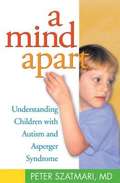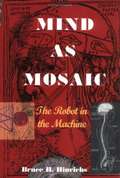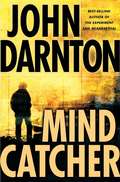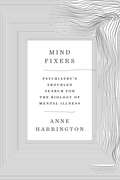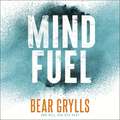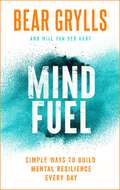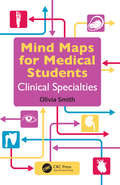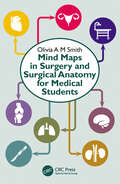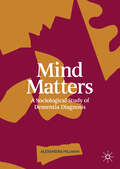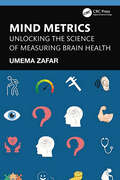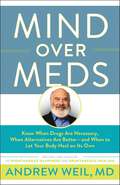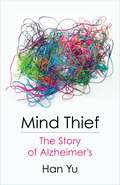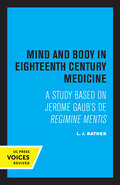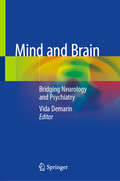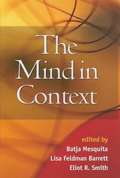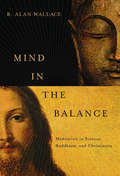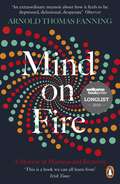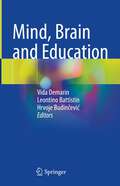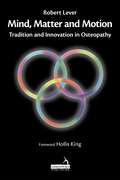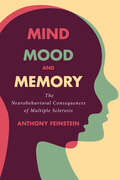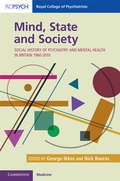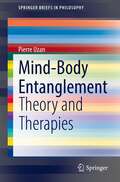- Table View
- List View
Mind Apart
by Peter SzatmariWhy would a child refuse to talk about anything but wasp wings-or the color of subway train doors? What does it mean when a nine-year-old asks questions about death hundreds of times a day? And how can parents build a close relationship with a little girl who hates to be touched? In this compassionate book, leading autism authority Dr. Peter Szatmari shows that children with autism spectrum disorders act the way they do because they think in vastly different ways than other people. Dr. Szatmari shares the compelling stories of children he has treated who hear everyday conversation like a foreign language or experience hugs like the clamp of a vise. Understanding this unusual inner world-and appreciating the unique strengths that thinking differently can bestow-will help parents relate to their children more meaningfully, and make the "outer world" a less scary place.
Mind As Mosaic: The Robot In The Machine
by Bruce H. HinrichsMind as Mosaic: The Robot in the Machine is a beguiling introduction to how the mind is created by the brain. With clarity, humor and poetry, Mind as Mosaic mixes history, biology, philosophy, artificial intelligence, and psychology in fresh, cutting-edge and insightful reading.People who drill holes in their heads, cannibals, electrical stimulation of brains, people who are blind but don't know it, and other absorbing and intriguing wonders are presented and explained in an uncompromisingly honest style that is compelling and accessible.Packed with startling and riveting examples and clear explanations of how the mind is robotically formed by brain processes, Mind as Mosaic is science wrapped in humanity, facts laced with wit, philosophy in a white laboratory coat. The subject is not only fun, it is profound.
Mind Catcher
by John Darnton13-year-old Tyler lies in a hospital, his brain damaged in an accident. Two doctors use their experiments to send Tyler far beyond medical science...
Mind Fixers: Psychiatry's Troubled Search For The Biology Of Mental Illness
by Anne HarringtonMind Fixers tells the history of psychiatry’s quest to understand the biological basis of mental illness and asks where we need to go from here. <P><P> In Mind Fixers, Anne Harrington, author of The Cure Within, explores psychiatry’s repeatedly frustrated struggle to understand mental disorder in biomedical terms. She shows how the stalling of early twentieth century efforts in this direction allowed Freudians and social scientists to insist, with some justification, that they had better ways of analyzing and fixing minds. But when the Freudians overreached, they drove psychiatry into a state of crisis that a new “biological revolution” was meant to alleviate. Harrington shows how little that biological revolution had to do with breakthroughs in science, and why the field has fallen into a state of crisis in our own time. <P><P>Mind Fixers makes clear that psychiatry’s waxing and waning biological enthusiasms have been shaped not just by developments in the clinic and lab, but also by a surprising range of social factors, including immigration, warfare, grassroots activism, and assumptions about race and gender. Government programs designed to empty the state mental hospitals, acrid rivalries between different factions in the field, industry profit mongering, consumerism, and an uncritical media have all contributed to the story as well. <P><P>In focusing particularly on the search for the biological roots of schizophrenia, depression, and bipolar disorder, Harrington underscores the high human stakes for the millions of people who have sought medical answers for their mental suffering. This is not just a story about doctors and scientists, but about countless ordinary people and their loved ones. A clear-eyed, evenhanded, and yet passionate tour de force, Mind Fixers recounts the past and present struggle to make mental illness a biological problem in order to lay the groundwork for creating a better future, both for those who suffer and for those whose job it is to care for them.
Mind Fuel: Simple Ways to Build Mental Resilience Every Day
by Bear GryllsThe world's most recognised adventurer Bear Grylls offers daily tips to help you build mental resilience.Bear Grylls draws on his survival experience to share the principles that have helped him overcome fear, develop a positive mindset and break through the obstacles that limit success in everyday life. With emotional health advocate Will Van Der Hart, MIND FUEL offers you practical insights to help you to increase your resilience, combat stress and live life with confidence.Topics are categorised into eight broader themes at enable you to access the material you need most - covering wisdom, battles, motivation, courage, relationships, self-care, spirituality and determination. From the bestselling author of Mud, Sweat and Tears, MIND FUEL gives you a whole year's worth of guidance to face whatever life throws at you.(P) 2022 Hodder & Stoughton Limited
Mind Fuel: Simple Ways to Build Mental Resilience Every Day
by Bear GryllsThe world's most recognised adventurer Bear Grylls offers daily tips to help you build mental resilience.Bear Grylls draws on his survival experience to share the principles that have helped him overcome fear, develop a positive mindset and break through the obstacles that limit success in everyday life. With emotional health advocate Will Van Der Hart, MIND FUEL offers you practical insights to help you to increase your resilience, combat stress and live life with confidence. Topics are categorised into eight broader themes at enable you to access the material you need most - covering wisdom, battles, motivation, courage, relationships, self-care, spirituality and determination. From the bestselling author of Mud, Sweat and Tears, MIND FUEL gives you a whole year's worth of guidance to face whatever life throws at you.
Mind Fuel: Simple Ways to Build Mental Resilience Every Day
by Bear GryllsThe world's most recognised adventurer Bear Grylls offers daily tips to help you build mental resilience.Bear Grylls draws on his survival experience to share the principles that have helped him overcome fear, develop a positive mindset and break through the obstacles that limit success in everyday life. With emotional health advocate Will Van Der Hart, MIND FUEL offers you practical insights to help you to increase your resilience, combat stress and live life with confidence. Topics are categorised into eight broader themes at enable you to access the material you need most - covering wisdom, battles, motivation, courage, relationships, self-care, spirituality and determination. From the bestselling author of Mud, Sweat and Tears, MIND FUEL gives you a whole year's worth of guidance to face whatever life throws at you.
Mind Maps for Medical Students Clinical Specialties
by Olivia SmithThis brand new revision aid has been designed as a companion to the popular Mind Maps for Medical Students, from the same author, to help medical students memorize essential facts in the key specialty areas of psychiatry, obstetrics & gynaecology, paediatrics, ophthalmology, ENT, dermatology and orthopaedics. With over 100 maps included, the book will be invaluable throughout medical studies and particularly useful in the pressured run-up to final exams.
Mind Maps in Surgery and Surgical Anatomy for Medical Students
by Olivia A SmithThis new learning and revision aid from the author of the bestselling Mind Maps for Medical Students has been designed specifically to help medical students memorise essential facts in surgical pathology and anatomy, invaluable throughout undergraduate studies, and particularly useful in the pressured run-up to final exams. Over 100 maps, charts, and tables are organised by surgical specialty and anatomical region as appropriate and reflect the latest surgical information and published guidelines. The book has been carefully designed with the student in mind – it is pocket sized and the maps summarise a variety of aspects in a consistent format to aid rapid recall. Ideally suited for students and early postgraduates revising for surgical exams, this convenient and portable distillation of knowledge will aid memorisation and save many hours of note taking.
Mind Matters: A Sociological Study of Dementia Diagnosis
by Alexandra HillmanAs population aging spreads to more parts of the world, dementia is fast becoming one of the most common and feared conditions of our time. Diagnosis has been identified as a key point of intervention for both biomedical and policy agendas. Drawing on ethnographic research spanning more than a decade, this book reflects on observations and recordings of UK memory clinic consultations, interview accounts with clinical staff involved in assessment and diagnosis, internationally recognised dementia researchers, and people living with dementia and their families both at the point of diagnosis and as their condition progresses. In dialogue with accounts and observations from the field, this book makes the case for the development of a sociology of dementia diagnosis. In doing so, the book progresses a dialectic approach to the study of dementia&’s construction and experience and contextualises dementia diagnosis within wider networks of meaning and systems of value related to aging, health, and personhood.
Mind Metrics: Unlocking the Science of Measuring Brain Health
by Umema ZafarBrain health, as opposed to mental health, is a neglected phenomenon, less discovered but now capturing more attention. Currently, the concepts surrounding brain health are vague and no clear definition of this term exists. Assessing brain health early in life may offer insights into impending disruptions in brain function. If deteriorating or poor health of the brain is detected at a young age, therapeutic steps can be taken. The definition of brain health is "the preservation of optimal brain integrity and mental and cognitive function at a given age in the absence of overt brain diseases that affect normal brain function." Recently, cognitive age has been used as a better indicator of brain health called the "cognitive clock." This book reviews, for example, fMRI, EEG, and PET scans as well as measuring certain blood and CSF biomarker levels. A new noninvasive, cost-effective, and easily implemented tool for gauging brain health is introduced. This tool can be used in rural communities as well as in low- and middle-income countries (LMIC). This book focuses on the development of this new tool for brain health measurement as well as its cross-validation in diseased and healthy populations.
Mind Over Meds: Protect Yourself From Overmedication By Knowing When Drugs Are Necessary And When Alternatives Are Better
by Andrew WeilToo many Americans are taking too many drugs -- and it's costing us our health, happiness, and lives.Prescription drug use in America has increased tenfold in the past 50 years, and over-the-counter drug use has risen just as dramatically. In addition to the dozens of medications we take to treat serious illnesses, we take drugs to help us sleep, to keep us awake, to keep our noses from running, our backs from aching, and our minds from racing. Name a symptom, there's a pill to suppress it. Modern drugs can be miraculously life-saving, and many illnesses demand their use. But what happens when our reliance on powerful pharmaceuticals blinds us to their risks? Painful side effects and dependency are common, and adverse drug reactions are America's fourth leading cause of death. In Mind over Meds, bestselling author Dr. Andrew Weil alerts readers to the problem of overmedication, and outlines when medicine is necessary, and when it is not. Dr. Weil examines how we came to be so drastically overmedicated, presents science that proves drugs aren't always the best option, and provides reliable integrative medicine approaches to treating common ailments like high blood pressure, allergies, depression, and even the common cold. With case histories, healthy alternative treatments, and input from other leading physicians, Mind over Meds is the go-to resource for anyone who is sick and tired of being sick and tired.
Mind Thief: The Story of Alzheimer's
by Han YuAlzheimer’s disease, a haunting and harrowing ailment, is one of the world’s most common causes of death. Alzheimer’s lingers for years, with patients’ outward appearance unaffected while their cognitive functions fade away. Patients lose the ability to work and live independently, to remember and recognize. There is still no proven way to treat Alzheimer’s because its causes remain unknown.Mind Thief is a comprehensive and engaging history of Alzheimer’s that demystifies efforts to understand the disease. Beginning with the discovery of “presenile dementia” in the early twentieth century, Han Yu examines over a century of research and controversy. She presents the leading hypotheses for what causes Alzheimer’s; discusses each hypothesis’s tangled origins, merits, and gaps; and details their successes and failures. Yu synthesizes a vast amount of medical literature, historical studies, and media interviews, telling the gripping stories of researchers’ struggles while situating science in its historical, social, and cultural contexts. Her chronicling of the trajectory of Alzheimer’s research deftly balances rich scientific detail with attention to the wider implications. In narrating the attempts to find a treatment, Yu also offers a critical account of research and drug development and a consideration of the philosophy of aging. Wide-ranging and accessible, Mind Thief is an important book for all readers interested in the challenge of Alzheimer’s.
Mind and Body in Eighteenth Century Medicine: A Study Based on Jerome Gaub's De Regimine Mentis
by L. J. RatherThis title is part of UC Press's Voices Revived program, which commemorates University of California Press’s mission to seek out and cultivate the brightest minds and give them voice, reach, and impact. Drawing on a backlist dating to 1893, Voices Revived makes high-quality, peer-reviewed scholarship accessible once again using print-on-demand technology. This title was originally published in 1965.
Mind and Brain: Bridging Neurology and Psychiatry
by Vida DemarinThis book discusses the link between the brain and the mind. Adopting an evidence-based neuropsychiatry approach while also touching on philosophical aspects, it examines the association between diseases of the brain and mental health, offering comprehensive insights into the emerging new discipline of psychoneuroendocrinoimmunology and its translation to clinical practice. The book particularly focuses on brain plasticity and on explaining the ability of the brain to learn new pathways in everyday situations and at the same time improve creativity.Written by clinicians and leading experts in the field of brain physiology and pathology, this book is a valuable resource for medical professionals and postgraduate students.
Mind in Context
by Lisa Barrett Batja MesquitaMost psychology research still assumes that mental processes are internal to the person, waiting to be expressed or activated. This compelling book illustrates that a new paradigm is forming in which contextual factors are considered central to the workings of the mind. Leading experts explore how psychological processes emerge from the transactions of individuals with their physical, social, and cultural environments. The volume showcases cutting-edge research on the contextual nature of such phenomena as gene expression, brain networks, the regulation of hormones, perception, cognition, personality, knowing, learning, and emotion.
Mind in the Balance
by B. Alan WallaceBy establishing a dialogue in which the meditative practices of Buddhism and Christianity speak to the theories of modern philosophy and science, B. Alan Wallace reveals the theoretical similarities underlying these disparate disciplines and their unified approach to making sense of the objective world. Wallace begins by exploring the relationship between Christian and Buddhist meditative practices. He outlines a sequence of meditations the reader can undertake, showing that, though Buddhism and Christianity differ in their belief systems, their methods of cognitive inquiry provide similar insight into the nature and origins of consciousness. From this convergence Wallace then connects the approaches of contemporary cognitive science, quantum mechanics, and the philosophy of the mind. He links Buddhist and Christian views to the provocative philosophical theories of Hilary Putnam, Charles Taylor, and Bas van Fraassen, and he seamlessly incorporates the work of such physicists as Anton Zeilinger, John Wheeler, and Stephen Hawking. Combining a concrete analysis of conceptions of consciousness with a guide to cultivating mindfulness and profound contemplative practice, Wallace takes the scientific and intellectual mapping of the mind in exciting new directions.
Mind in the Balance: Meditation in Science, Buddhism, and Christianity (Columbia Series in Science and Religion)
by B. Alan WallaceBy establishing a dialogue in which the meditative practices of Buddhism and Christianity speak to the theories of modern philosophy and science, B. Alan Wallace reveals the theoretical similarities underlying these disparate disciplines and their unified approach to making sense of the objective world. Wallace begins by exploring the relationship between Christian and Buddhist meditative practices. He outlines a sequence of meditations the reader can undertake, showing that, though Buddhism and Christianity differ in their belief systems, their methods of cognitive inquiry provide similar insight into the nature and origins of consciousness. From this convergence Wallace then connects the approaches of contemporary cognitive science, quantum mechanics, and the philosophy of the mind. He links Buddhist and Christian views to the provocative philosophical theories of Hilary Putnam, Charles Taylor, and Bas van Fraassen, and he seamlessly incorporates the work of such physicists as Anton Zeilinger, John Wheeler, and Stephen Hawking. Combining a concrete analysis of conceptions of consciousness with a guide to cultivating mindfulness and profound contemplative practice, Wallace takes the scientific and intellectual mapping of the mind in exciting new directions.
Mind on Fire: Shortlisted for the Wellcome Book Prize 2019
by Arnold Thomas FanningShortlisted for the Wellcome Book Prize 2019'[A] painfully intense, courageous and gripping account of [Fanning's] journey to the underworld of madness and back. This is a brave and instructive book.' Irish Times'Extraordinary. An account of mental illness, grief, delusions, homelessness, a fractured family relationship ... and all while trying to recover and create. Superb writing on a frequently difficult subject.' Sinéad Gleeson Arnold Thomas Fanning had his first experience of depression during adolescence, following the death of his mother. Some ten years later, an up-and-coming playwright, he was overcome by mania and delusions. Thus began a terrible period in which he was often suicidal, increasingly disconnected from family and friends, sometimes in trouble with the law, and homeless in London.Drawing on his own memories, the recollections of people who knew him when he was at his worst, and medical and police records, Arnold Thomas Fanning has produced a beautifully written, devastatingly intense account of madness - and recovery, to the point where he has not had any serious illness for over a decade and has become an acclaimed playwright. Fanning conveys the consciousness of a person living with mania, psychosis and severe depression with a startling precision and intimacy. Mind on Fire is the gripping, sometimes harrowing, and ultimately uplifting testament of a person who has visited hellish regions of the mind.'Arnold Thomas Fanning offers the most vivid and unflinching window into the mind of someone who is in the throes of madness ... It was like nothing I'd read before' Rick Edwards'Mind on Fire is a truly powerful, arresting, haunting account. Arnold Thomas Fanning has reckoned with the darkest matter of his heart and mind, and I challenge anyone not to be moved by that.' Sara Baume, author of Spill Simmer Falter Wither and A Line Made by Walking'In this strange and singular book, Arnold Thomas Fanning mercilessly excavates the infernal underworld of his own years of madness. As reminiscent as it occasionally is of John Healy's The Grass Arena, and even of Orwell's Down and Out in Paris and London, the book is ultimately not quite like anything else I've read, and brought me as close to the lived reality of mental illness as I have ever been. It's a significant achievement: a painful, inexorable work of autobiography, whose existence is its own form of redemption.' Mark O'Connell, Baillie Gifford Prize-shortlisted author of To Be a Machine'This is an extraordinary memoir about how it feels to be depressed, delusional, desperate' The Observer 'Incredibly important' Emilie Pine, author of Notes to Self'A ratcheting pace, a tight first-person immediacy, and utterly staggering to be a passenger over its entire warped course ... An indelible, ground-shaking account' Hilary A White, Irish Independent, Memoir of the Year, Best Reads of 2018'A spellbinding memoir that should prove both moving and hopefully cathartic for the reader.' RTE Culture 'Told in tight and immediate first-person, and imbued with a startling momentum that ratchets unnervingly, Fanning's publishing debut ... is a significant achievement and should be a talking point in publishing this year.' Irish Independent 'Fanning's debut book lays it on the line in a deeply personal and compelling chronicle of his descent into depression and his way back out.' RTE Guide'Wonderful' Joseph O'Connor, Irish Times Books of the Year'Unsparingly direct, searing and honest ... It is gripping to read and must have been exhausting to live' Medical Independent 'One of the most gripping and revealing memoirs I've read in a long time. A controlled and artful exploration of absolute loss of control, an uns
Mind, Brain and Education
by Leontino Battistin Vida Demarin Hrvoje BudinčevićThis book, Mind, Brain and Education, comprises selected topics from Neurology and Psychiatry, showing both their common ground and their differences. A special emphasis is given to the role of scientific gathering with the Mind & Brain Congress as a platform for educating younger colleagues and widening their perspectives in the field of both disciplines. With the new discipline of Psychoneuroendocrinoimmunology (PNEI) and its translation to clinical practice, our long-standing comprehensive approach to the interrelation and bridging of the mind and the brain contributes to a better understanding of this challenging topic. The reader can find new facts showing how diseases are the result of an alteration at the bio-psycho-social level. PNEI provides knowledge about the biological dynamics of conventional medicine and of the importance of lifestyle changes in order to fight disease. Written by experts in the field, the exceptional new approach provided by this book, makes it an innovative tool for spreading new knowledge, and implementing it in everyday clinical practice for the benefit of patients and even more so, to prevent them becoming patients in the first place.
Mind, Make-Believe and Medicine: Exploring the Divide Between Science and Wishful Thinking
by Richard RaskerThis book delves into the world of alternative medicine and related phenomena in several different ways, both from a scientific perspective and the perspective of supporters and practitioners of those phenomena.An attempt is made to explain not only what those perspectives are, but also why they are often so radically different. Why do lots of people believe things that other people don't? To find answers, we don't just examine the things people believe in or not, but also human traits in thinking, reasoning and belief.
Mind, Matter and motion: Tradition and Innovation in Osteopathy
by Robert LeverThis book is an adventurous foray into the subtle aspects of osteopathic diagnosis and treatment, the 'energetic' dimension in relation to the Lesion, the patient/practitioner exchange and touch; the clinical 'art' and the alchemy of practice. The role of visualisation and intention; the mind/matter dichotomy; the evolving view of osteopathy in relation to its proud legacy, and its often troubled place within the medical world. The vital balance between tradition and innovation and the enduring importance of our fundamental principles. Much of this book is relevant to other healthcare practices and might have appeal for other health professionals who also share some interest in osteopathy.
Mind, Mood, and Memory: The Neurobehavioral Consequences of Multiple Sclerosis
by Anthony FeinsteinA unique resource for all health care practitioners caring for people with multiple sclerosis.Endorsed by The Consortium of Multiple Sclerosis CentersMultiple sclerosis (MS), a progressive neurologic disease, is characterized by a host of physical symptoms. But the neurobehavioral consequences of MS can be as devastating and debilitating as physical symptoms, and they are often unreported and undertreated. In this new book, Dr. Anthony Feinstein, a neuropsychiatrist, documents the effects of MS on cognition, information processing speed, learning and memory, executive function, personality, mood, and behavior.Feinstein touches on a number of topics, including• the common cognitive challenges that occur with MS, such as slowed information processing speed, impaired memory, and executive function deficits • psychiatric disorders that accompany MS, such as depression and psychosis• current neuropsychological, brain MRI, and treatment data applicable to the psychiatric and cognitive disordersMind, Mood, and Memory in Multiple Sclerosis is enhanced both by the latest science and by eloquent case histories that illustrate each cognitive and emotional disorder. Feinstein also provides recommendations for evidence-based therapeutic interventions. Written in an immediate, accessible way, this book has a crossover appeal, making it of interest not only to neurologists, psychiatrists, neuropsychiatrists, neuropsychologists, psychologists, occupational therapists, and nurses but also to people with MS and their caregivers, family, and friends.
Mind, State and Society: Social History of Psychiatry and Mental Health in Britain 1960–2010
by Nick Bouras George IkkosMind, State and Society examines the reforms in psychiatry and mental health services in Britain during 1960–2010, when de-institutionalisation and community care coincided with the increasing dominance of ideologies of social liberalism, identity politics and neoliberal economics. Featuring contributions from leading academics, policymakers, mental health clinicians, service users and carers, it offers a rich and integrated picture of mental health, covering experiences from children to older people; employment to homelessness; women to LGBTQ+; refugees to black and minority ethnic groups; and faith communities and the military. It asks important questions such as: what happened to peoples' mental health? What was it like to receive mental health services? And how was it to work in or lead clinical care? Seeking answers to questions within the broader social-political context, this book considers the implications for modern society and future policy. This title is also available as Open Access on Cambridge Core.
Mind-Body Entanglement: Theory and Therapies (SpringerBriefs in Philosophy)
by Pierre UzanThis book suggests a radical departure in approaching the mind-body problem. Instead of trying to causally relate subjective experience to the functioning of the body, it begins with the notion of the psychosomatic unity of the individual and looks for its conditions of possibility. This text shows that what makes this unity possible is the generalized entanglement relation that connects a person's subjective experience with its body functioning in a specific way.In addition to providing a significant contribution to the long-standing philosophical debate about the nature of the mind-body connection, this change of perspective based on the concept of generalized entanglement allows for exploring a holistic approach to health. It can for example explain the existence of body memory and leads to a better understanding of the genesis and evolution of internal diseases, allowing for the development of mind-body therapies. This volume also provides new insights into mental disorders and sets the theoretical basis of self-healing methods appealing to students, researchers and professionals in the fields.
